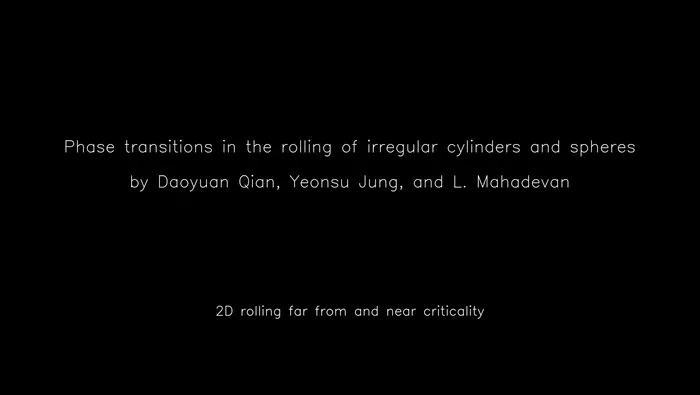How gravity influences the motion of a perfect spherical ball rolling down an inclined surface is a fundamental concept often introduced in elementary physics classrooms. Yet, the complexities of real-world interactions reveal a broader landscape. Researchers from the Harvard John A. Paulson School of Engineering and Applied Sciences (SEAS) have embarked on an exploration to unravel the intricate rolling dynamics of irregularly shaped objects. Under the guidance of L. Mahadevan, the Lola England de Valpine Professor of Applied Mathematics, Physics, and Organismic and Evolutionary Biology at Harvard, this study combines theoretical frameworks, simulation models, and experimental investigations to shed light on the behaviors of these flawed spheres.
The pivotal research, featured in the esteemed Proceedings of the National Academy of Sciences, emerged from a mere curiosity about day-to-day phenomena. It unravels more than just the mechanics of rolling; it unveils insights applicable across various scientific domains—from cellular transport mechanisms at the nanoscale to advancements in robotics. The researchers set out to determine how an imperfectly shaped sphere responds when placed at varying angles on an incline, producing findings that could revolutionize our understanding of motion in non-ideal scenarios.
The research team began their investigation with advanced simulations, focusing on slightly irregular geometries, oscillating between sphere and cylinder shapes. They discovered a critical angle—the point of transition—dictating whether an object would glide down the slope or come to a halt. This threshold is not merely a physical boundary but a phenomenon rich with fascinating physics. As the incline steepens, the likelihood of rolling increases; conversely, a flatter incline promotes stasis. Daoyuan Qian, the first author and a former research fellow in Mahadevan’s group, elucidated the significance of this critical transition point, which parallels the characteristics associated with phase transitions.
Herein lies an unexpected revelation: the behavior of objects at this critical junction exhibits the properties of phase transitions typically observed in physical systems. When nearing the transition point, the rolling speed emerges as a fundamental measure of order. The authors observed how this speed fluctuates based on parameters such as the object’s dimensional attributes and its inertia. They identified that at the transition boundary, the time required for rolling escalates dramatically, only settling into consistent motion upon drifting away from the critical condition. Their observations suggested that rolling behaviors would diverge between cylindrical and spherical objects, pointing to the fundamental differences in their rotational dynamics.
Validating their theoretical predictions, the researchers proceeded to empirical tests within a laboratory environment, where rolling cylinders and spheres were subjected to various inclinations. Astonishingly, the experimental outcomes congruently reflected their earlier calculations, reaffirming the validity of their model and elucidating the peculiarities surrounding the onset of motion. These findings not only enhanced the understanding of rolling dynamics but also revealed a captivating visual spectacle—irregular objects displayed novel movement patterns, akin to the erratic paths traversed by a dung beetle transporting its payload.
Among other surprises uncovered in the study, was the periodic nature of motion that became apparent as the researchers exemplified the trajectories of the irregular spheres. Despite their unpredictable appearances, a striking order emerged as they observed that regardless of the irregularities, the spheres ultimately displayed a predictable, repeating pattern in their rolling motions—a discovery that Qian noted was particularly remarkable. This periodicity signified a deeper underlying structure within the seemingly chaotic dynamics of rolling irregularities.
The results of this research vividly illustrate long-standing mathematical theorems, infusing abstract concepts with tangible manifestations through this simple experiment. Mahadevan referenced the intriguing link to the “Hairy Ball Theorem,” which whimsically states that it is impossible to comb a sphere’s hair without creating at least one cowlick. This theorem’s essence resonates through the evident patterns of rolling trajectories observed on the sphere’s surface. Furthermore, the experiments tangibly embody Dirac’s Plate Trick, elucidating necessary conditions for a rotating object with attached strings to revert to its original state—a concept that squarely links mathematical theory to empirical evidence.
At the intersection of physics and mathematics, the findings beckon further exploration within the context of broader scientific inquiries. Co-author and postdoctoral researcher Yeonsu Jung emphasized the significance of making abstract mathematical concepts accessible through these experiments, raising the question of what additional phenomena could yield fresh insights if examined through similar lenses. The hope is that this research not only enhances our grasp of rolling mechanics but spurs new questions and explorations within both mathematics and physics.
The implications of this research extend beyond the immediate fascination with rolling objects. They touch upon fundamental principles that govern motions in diverse fields, be it in the study of cellular structures or innovations in robotic movement. As scientists continue to bridge the gap between theory and empirical study, the fruits of this investigation illuminate pathways for transformative advancements across disciplines, showcasing the interconnected nature of science and the sheer power of curiosity-driven inquiry.
The research underscored the importance of curiosity in scientific exploration. Mahadevan articulated that the act of pausing to ponder the world’s nuances allows for profound revelations, not only about the external universe but also self-discovery. The connections drawn between different areas within mathematics and physics through addressing this uncomplicated query exemplify the extensive scope of inquiry that beckons researchers to look beyond the surface.
Funding for this innovative study was sourced from several notable institutions, including Transition Bio Ltd, Cambridge University, the National Research Foundation of Korea, the Simons Foundation, and the Henri Seydoux Fund, which underscores the collaborative nature of scientific advancement. As the scientific community reflects on the study, it serves as a reminder of the potential that lies in the exploration of everyday phenomena, motivating future research endeavors that prioritize curiosity, creativity, and interdisciplinary cooperation.
Subject of Research: Dynamics of rolling irregular objects
Article Title: Phase transitions in the rolling of irregular cylinders and spheres
News Publication Date: 5-Mar-2025
Web References: Proceedings of the National Academy of Sciences
References: 10.1073/pnas.241716112
Image Credits: Mahadevan Group / Harvard SEAS
Keywords: Mathematical physics, Experimentation, Phase transitions, Speed, Applied mathematics, Applied physics, Mechanics, Classical mechanics, Theoretical physics




